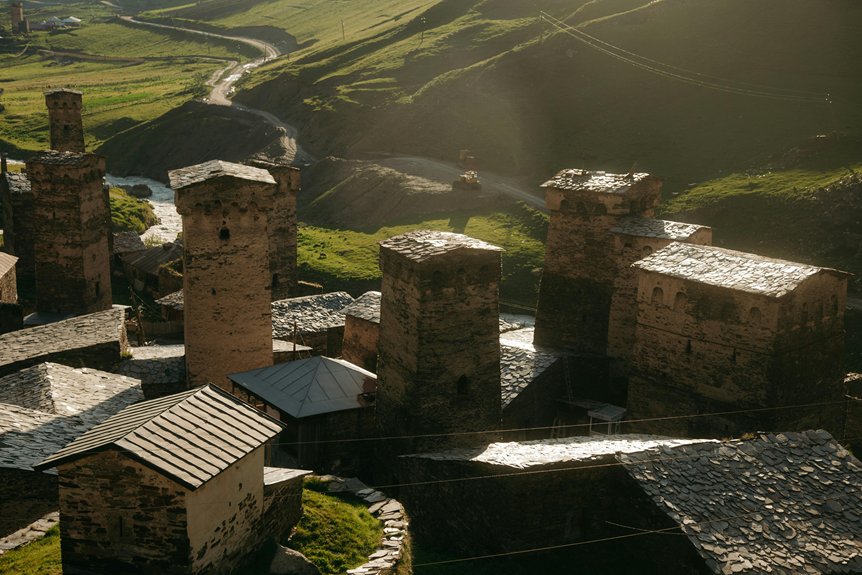Cyprus highland villages strategically use stone construction as an ecological adaptation to challenging mountainous environments. You’ll find their xerolithia (dry-stone) techniques optimize thermal regulation, leveraging local limestone’s natural insulative properties. These architectural methods transform geological resources into resilient structures that moderate indoor temperatures, withstand harsh climatic conditions, and reflect generations of environmental engineering wisdom. Intrigued? Archaeological insights await your exploration.
Key Takeaways
- Stone construction provides superior thermal regulation in highland environments, maintaining comfortable indoor temperatures through thick walls and natural insulation.
- Local limestone and other geological materials are abundantly available in Cyprus highlands, making stone the most practical and economical building resource.
- Dry-stone walling techniques (“xerolithia”) enable resilient structures that withstand harsh mountain climate conditions and seismic activity in the region.
- Stone buildings represent a centuries-old cultural tradition of architectural adaptation, reflecting generations of ecological wisdom and landscape interaction in highland communities.
- Stone construction offers exceptional durability and structural integrity, allowing highland villages to create long-lasting settlements that can endure extreme weather challenges.
Historical Origins of Stone Construction in Cyprus
While archaeological evidence reveals a rich architectural heritage, the historical origins of stone construction in Cyprus trace back to prehistoric settlements that strategically utilized local geological resources. The vernacular architecture of Cyprus highland villages emerged from a sophisticated understanding of landscape interaction and material availability.
You’ll observe that ancient Greek-style city-states established sophisticated stone construction techniques, leveraging limestone, sandstone, shell rock, and granite as primary building materials. These early settlements demonstrated remarkable engineering prowess by developing drystone building methods that responded directly to challenging topographical conditions.
The xerolithia technique-carefully stacking stones without mortar-represented more than a construction method; it embodied a cultural adaptation to mountainous terrains. Highland villagers developed intricate stone-stacking strategies that prevented landslides, managed water flow, and mitigated soil erosion. This architectural approach transformed local geological challenges into structural opportunities, revealing the profound connection between Cyprus’ landscape and its architectural traditions.
Traditional Building Techniques and Materials
As traditional Cypriot highland architecture evolved, stone construction techniques emerged as a sophisticated response to environmental constraints and cultural imperatives. You’ll find that the “xerolithia” dry-stone walling method represents a pinnacle of architectural ingenuity, carefully stacking local limestone, sandstone, shell rock, and granite without mortar to create structurally resilient dwellings.
The strategic selection of indigenous stone materials isn’t merely aesthetic but functionally critical. These stones naturally moderate indoor temperatures, providing thermal regulation essential in the Mediterranean climate. Your attention to the courtyard design reveals another technical innovation: stone-paved floors and integrated living spaces that maximize functional efficiency.
Each architectural element serves a precise purpose. The compact room layouts reflect resource optimization, while integrated features like traditional ovens demonstrate how construction techniques directly respond to cultural food preparation practices. This holistic approach transforms stone from a mere building material into a sophisticated cultural and environmental adaptation mechanism.
Environmental Adaptation and Climate Resilience
Stone construction in Cyprus highland villages emerges as a sophisticated ecological response to challenging Mediterranean environmental conditions. You’ll observe that stone structures provide exceptional thermal mass, effectively regulating interior temperatures by absorbing heat during daytime and releasing it gradually during cooler nights. This natural climate control mechanism significantly reduces energy consumption and enhances residential comfort.
You’ll notice that stone’s inherent properties-high density and low thermal conductivity-create natural insulation barriers against extreme temperature fluctuations. Highland villagers strategically utilized local stone materials, which possessed remarkable durability and resistance to weathering. These architectural choices weren’t merely aesthetic but pragmatic survival strategies adapted to harsh mountainous microclimates.
The construction technique demonstrates remarkable environmental intelligence, transforming geological resources into resilient living spaces. Stone walls’ thick dimensions and strategic orientation mitigate solar radiation’s intensity while maintaining ideal internal temperature ranges. Your understanding of these traditional building methods reveals a profound ecological wisdom embedded in Cyprus’s architectural heritage.
Cultural Significance of Dry Stone Walling
Because dry stone walling represents more than mere architectural technique, it embodies a profound cultural narrative deeply rooted in Cypriot highland communities’ collective memory and social practices. You’ll find that this construction method transcends functional necessity, symbolizing resilience, communal identity, and intergenerational knowledge transfer. The technique reflects a sophisticated understanding of landscape interaction and ancestral wisdom.
| Cultural Aspect | Social Meaning | Historical Context |
|---|---|---|
| Construction | Collective Labor | Community Bonding |
| Material Selection | Skill Demonstration | Generational Expertise |
| Wall Design | Territorial Marking | Landscape Adaptation |
| Maintenance | Social Responsibility | Cultural Preservation |
| Technique Transfer | Apprenticeship | Knowledge Inheritance |
You’ll recognize dry stone walling as more than structural engineering-it’s a living cultural artifact. Each stone placement communicates generational knowledge, embodying spatial relationships, economic constraints, and social dynamics intrinsic to Cypriot highland communities. The walls aren’t just barriers; they’re narrative landscapes encoding complex sociocultural interactions and environmental adaptations.
Preservation and UNESCO Heritage Recognition
How can a centuries-old architectural tradition transcend mere construction and become a globally recognized cultural treasure? UNESCO’s recognition of dry stone walling in Cyprus has elevated traditional stone house preservation from a local practice to an international heritage conservation effort. You’ll find that this acknowledgment isn’t just symbolic; it provides tangible incentives for maintaining historic structures.
Cyprus offers strategic conservation grants specifically designed to motivate property owners in preserving traditional stone houses. To qualify, you must meticulously adhere to original construction techniques and architectural integrity. These grants serve a dual purpose: financial support and cultural preservation.
The UNESCO heritage status transforms stone house conservation from a potential economic burden into a valuable cultural investment. By supporting these preservation efforts, you’re not just maintaining buildings; you’re safeguarding generations of architectural knowledge, craftsmanship, and cultural identity embedded in each carefully constructed stone structure.
Economic and Tourism Impacts of Stone Architecture
The architectural heritage preserved through UNESCO recognition directly catalyzes economic revitalization in Cyprus’ highland villages. Stone architecture transforms traditional settlements into compelling tourist destinations, generating significant revenue streams through cultural heritage tourism.
| Tourism Impact | Economic Benefit |
|---|---|
| Visitor Numbers | Annual Revenue Increase |
| Architectural Preservation | Local Business Growth |
| Cultural Experience | Sustainable Development |
You’ll observe that stone construction attracts international travelers seeking authentic cultural experiences. Restoration projects create employment opportunities for local artisans, stonemasons, and hospitality professionals. The unique architectural landscape becomes a strategic economic asset, driving tourism investment and regional development.
Scholarly research indicates that heritage tourism centered on stone architecture generates approximately 15-20% additional income for highland communities. These economic advantages extend beyond immediate tourism revenues, stimulating ancillary sectors like handicrafts, local cuisine, and traditional accommodation services. The intrinsic value of stone architecture thus transcends aesthetic preservation, becoming a crucial economic revitalization mechanism for Cyprus’ highland regions.
Frequently Asked Questions
What Are Houses Made of in Cyprus?
In Cyprus, you’ll find houses primarily constructed from natural stone materials like limestone, sandstone, shell rock, and granite. These stones are strategically selected based on local geological availability and architectural requirements. You’ll observe traditional drystone building techniques (xerolithia) that ingeniously assemble stones without mortar, creating durable structures adapted to the Mediterranean climate’s challenging environmental conditions.
What Is the Stone of Cyprus?
You might think stone’s just stone, but Cyprus’s limestone tells a different tale. This sedimentary rock, formed from marine organism remnants, dominates the highland architectural landscape. Characterized by its exceptional durability and weathering resistance, the local limestone becomes more than a building material-it’s a geological narrative. You’ll find it embedded in traditional masonry techniques, representing the region’s structural and cultural resilience.
What Is the Dry Stone Construction Method?
The dry stone construction method involves precisely stacking stones without mortar, utilizing strategic interlocking techniques that create structural integrity through precise stone placement. You’ll find each stone carefully selected and positioned to maximize stability, with strategic gaps allowing for natural movement and load distribution. This technique relies on skilled craftsmanship, where stones’ shapes and weights are meticulously arranged to guarantee structural resilience and long-term durability.
Conclusion
Like a resilient fortress standing against time’s erosive touch, Cyprus’ highland stone villages embody architectural brilliance rooted in survival. You’ll discover these structures aren’t merely buildings, but living testimonies of environmental adaptation. Stone construction represents an intricate dialogue between human ingenuity and landscape, where traditional building techniques transform geological resources into sustainable, climatically intelligent dwellings that have withstood centuries of ecological challenges.

Meet Natalie, who has lived on Cyprus for the last 10 years. She loves exploring the beautiful nature of the island, like quiet forests and untouched beaches. Natalie has lots of cool experiences to share. Join her as she talks about her adventures in Cyprus.

